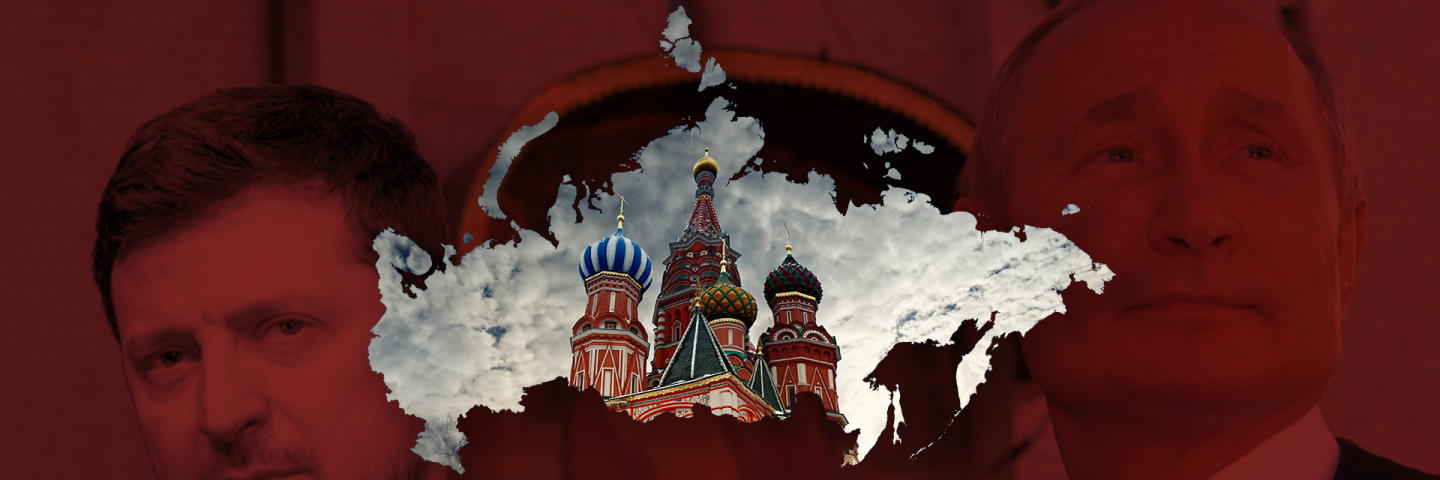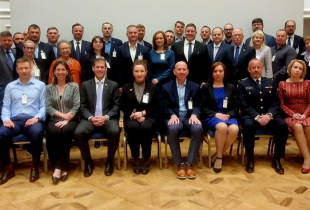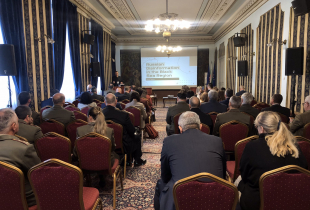
Russia End State: EU and U.S. Aid and Ukraine?
Introduction
2024 will be a critical year in the comparative ability of Russia and Ukraine to rebuild their offensive combat capability. Western choices regarding training, materiel supplies, and security commitments to Ukraine will determine Ukraine’s ability to settle the war on terms that best serve its state and its people, in the present and future. The outcome of the conflict has the potential to shape the logic of the international system, starting with Euro-Atlantic security order and the norms it lives by. But its effects will resonate further afield, impacting security dynamics in the Indo-Pacific region as well as the thinking among non-aligned states facing more powerful adversaries, particularly on the utility of nuclear deterrence – and so proliferation. The West and Ukraine are in the war together and need a shared strategy based on a common understanding of Ukrainian victory. Let us unpack such stark propositions.
U.S. Assistance
Although a majority of U.S. politicians in both the House and Senate support passing a $61 billion aid supplemental spending package for Ukraine, some Republican Party representatives in the House are using the aid package as leverage to ensure stricter border controls with Mexico and to restrict presidential powers regarding migration (“humanitarian parole authority”). Negotiations are ongoing, with President Biden summoning Congressional leaders to a meeting this week to discuss options. This aid package is not “money given to Ukraine” but rather will be used to purchase supplies that replenish U.S. stockpiles that have been depleted in order to provide weapons and ammunition to Ukraine. The United States could, in theory, further reduce such stockpiles without using the supplemental funding, but this would damage U.S. force readiness.
How dependent is Ukraine on U.S. military assistance? F-16s, tanks, and long-range missiles receive media attention, but air defense interceptors and ammunition are more important for sustaining Ukraine’s ability to fight. Ukraine’s ground forces are an artillery-first military and artillery need shells. At the height of Ukraine’s counter-offensive in Summer/Fall of 2023, Ukraine was using up to 10,000 shells per day, now reduced to around 2,000 when on defense and conserving ammunition. The United States is Ukraine’s main supplier of 155 mm artillery shells. There is a time lag of up to 4 months between authorization of delivery of weapons and the actual delivery – Ukraine is now receiving weapons authorized last Fall. While Ukraine can survive a gap of a few months in supplies, the longer the gap continues, the bigger the problem it will have in maintaining the ability to fight.
European Support
The EU supports Ukraine through its decision to initiate accession talks, its commitment to Ukrainian victory along Ukraine’s 1991 state borders, and a Russia policy that seeks to punish and isolate Russia through economic sanctions. The EU also gives direct aid to Ukraine. The EU aid package for Ukraine consists of a Euro 50 billion (US $60 billion) money transfer. This aid is currently held hostage by Hungarian Prime Minister Viktor Orbán who, in a pragmatic and cynical fashion, (but also perhaps from genuine belief that it is not if but rather when Russia “wins” and the status quo ante resumes) uses this issue to extract concessions from the EU. Hungary will head the European Council Presidency for 6 months from June 2024 and this affords it the opportunity to use delaying tactics, but not the ability to fundamentally reshape EU policy. Bureaucratic battles will become more intense (with more ink spilt and paper consumed, to use pre-digital metaphors).
At the end of February, this package, or something very much like it, will be provided. Europeans can provide money, a crucial element supporting Ukraine’s war effort. But there is a disparity across Europe in terms of national leadership and political willingness to provide aid. The provision of aid by European states is not in and of itself a strategy. Vague notions of 2024 as a “building year” in terms of European coalitional support (in parallel with Ukraine’s regrouping for a major 2025 push on the battlefield) need to define the end objectives of its aid, goodwill, and political support. Although not exactly a strategy, the components are there. First, allies and partners with shared values and consensus regarding threat assessment need to pull in the same direction. However ad hoc and organic the effort, the net effect is to tie Russia down and bond allies together. Second, milestones towards EU and NATO membership are crucial to western strategy, in that they function to give Ukraine hope and direction and demonstrate to Russia that its windows of influence and strategic relevance are closing. Third, there needs to be some kind of shared vision of an endgame, an outcome, and how to manage it. This is the most speculative and least defined.
Managing the political challenges within the western coalition in the context of a long attritional war in which western “boots on the ground” are a strictly understood “red line” will be complex. In July 2022, the UK and other Ukrainian partners established “Operation Interflex” to train Ukrainian troops in a 5-week program. The UK has also committed to a £2.5 billion 10-year security and defense cooperation (bilateral “security guarantees”) agreement with Ukraine. Canada and at least 2 other G7 nations are close to opening negotiations with Ukraine with similar packages in mind. Though these commitments are not legally binding, these agreements should solidify resource support to Ukraine for the foreseeable future. The idea of such commitments is to bridge the gap between the end of the war and NATO membership.
Might the United States and Europe sequester $300 billion of Russian assets frozen in early 2022, largely held by Euroclear, a Belgian financial institution, and the New York Federal Reserve? These funds could then support Ukraine’s reconstruction efforts (which may cost $1 trillion), boost Ukraine’s morale, and hold Russia accountable for starting a major war that inflicts costly physical infrastructure and other damage on Ukraine, acting as a down payment on eventual Russian war reparations. As this would also boost Ukraine’s macro-economic stabilization, it would allow western allies to pivot more of their own aid from economic to military support. Such a move would be unprecedented and might deter other countries from depositing their funds with Euroclear or holding them in dollars. In addition, as the sequestered assets would be used to compensate all states and private entities harmed by Russian actions related to the war, it creates incentive for local actors, including the Russian state, to seize Western firms’ Russian operations, since such seizures would create more claimants for the money and reduce the amount of funding actually going to Ukraine. However, failure to seize Russian assets in the West would perversely signal that wars of aggression that violate International Law are permissible to the extent that they are not punished by the established financial system.
Russia: “Forward to Victory?”
Russia is currently at peak performance in terms of its domestic arms production and is receiving materiel imports from North Korea and Iran. On December 14, 2023 at the hybrid ‘Direct Line’ and annual press conference, Putin made clear his goals regarding Ukraine: de-Nazification and de-militarization. The former entails full political control of Ukrainian domestic politics – whoever seeks autonomy and independence will be labelled a Nazi (down to the level of Ukrainian language teacher and museum director); the latter translates into imposed neutrality and Russia’s direct control of Ukraine’s strategic orientation. Putin also signaled that western support was weakening and that time was on Russia’s side.
However, why does Russia waste manpower on high-casualty attrition attacks if Putin truly believes time is on Russia’s side? One reason might be that even at Russian peak performance, Ukraine is not struggling. Indeed, Ukraine has been able to carry out targeted spectacular missile attacks sinking Russia’s Large Landing Ship “Novocherkassk” and on January 15, 2024 a Russian A-50 AWACS and an IL-22 command post aircraft. In response to Ukraine signing its security and defense assistance agreement with the UK, former Russian President Dmitry Medvedev responded on X, formerly known as Twitter, with a tweet to the effect that if the UK deploys “their official military contingent in Ukraine” this “will mean a declaration of war on our [i.e. Russia] country” and such troops would be targeted by Russian cluster munitions in Kyiv.
Five factors suggest that Russia, on the eve of its presidential election March 15-17, 2024, is set to lose the strategic initiative. First, the EU’s aid package or its “Plan B” variant will likely be passed at the end of January. Second, the U.S. package has strong bipartisan support. Third, Ukraine’s Verkhovna Rada is set to pass mobilization legislation which will suffice for the next 6 months. Such mobilization demonstrates to Ukraine’s western partners that Ukraine will do all that it can to defend itself and that its self-belief is unshakeable. Fourth, seizure of Russian frozen assets is not contingent on collective action: the United States may first sequester Russian assets held by the New York Federal Reserve, providing political cover for Euroclear to follow. The question then: how does Ukraine allocate money received in compensation for war damages? Fifth, Ukraine is going to acquire a set of new capabilities including F-16s (which might add both interception of Russian cruise missiles and the ability to launch long-distance strikes), German KEPD 350 Taurus missiles (the decision is pending, but is certain to happen), more French SCALP-EG missiles (as announced by Macron on January 16, 2024), and mine-clearance capabilities. Sub-regional western cooperative efforts, such as a Turkish-Romanian-Bulgarian maritime joint task force may be able to utilize UK donated minesweepers to clear the Black Sea of Russian mines.
Conclusions
Putin himself has restated what a Russian victory means, if only obliquely through coded phrases such as “de-Nazification” and “de-militarization.” With regards to “Ukrainian victory” – implicit assumptions need to be made explicit. One assumption is that if Ukraine breaks the “land bridge” to Crimea, Russia’s military effort collapses. Another is that Ukraine is able to win the kind of total victory that not only restores it to its 1991 borders but removes any need for subsequent negotiations with Moscow. But might this only imply that the battlefront shifts to Ukraine’s 1991 state borders? Rather than “peace,” Russia continues to fight.
“If Ukraine wins, Russia must have lost” is an equally shaky proposition in that it reduces the war to a strategic victory/defeat binary. Such a black-and-white understanding does not account for the loser being the one who decides it has lost. In other words, Ukraine may not be winning but Russia, as with the United States in Vietnam (or the Soviet Union in Afghanistan), may decide it has lost. Russian leaders might decide at some point in the future that even with a continuing advantage in manpower and materiel, they no longer have the will to continue the fight. This then suggests that Ukraine can focus on a campaign of strategic humiliation to break the political will of Russia to fight by visibly puncturing Kremlin narratives and so undermining Putin’s standing within the state on the eve of his “first” presidential victory. Current Russian personnel casualties (which range between 200,000-350,000) and equipment losses are hardly sustainable.
A last factor is that of the United States and predictability of continued support for Ukraine – of policy continuity. At a President Biden and President Zelenskyy joint press conference on December 12, 2023, President Biden confirmed that “we’ll continue to supply Ukraine with critical weapons and equipment as long as we can,” but noted that unless supplemental funding is forthcoming: “we’re rapidly coming to an end of our ability to help Ukraine respond to the urgent operational demands that it has.” This represented a subtle shift in tone from the Biden administration’s prior unqualified “for as long as it takes” formulation.
Former President Trump is the prohibitive favorite to win the Republican presidential primary. While a new law has been passed that prevents any president from unilaterally withdrawing the United States from NATO, a potential Trump administration will likely push for “burden shifting” over transatlantic “burden sharing.” We may “touch this void” of a “dormant NATO,” but there is little, if any, discussion on the implications of how this void might be filled by remaining non-U.S. NATO members, beyond recognizing the necessity of greater investments in European defense industries and manufacturing. This possibility of such a radical rupture may prove the impetus to create a workable common strategy with Ukraine. President Zelenskyy’s visits to Nordic and Baltic States and the UK prime minister’s visit to Kyiv point to Ukraine’s strongest supporters and perhaps the nucleus of a Plan B embryonic European (plus Canada) coalition in support of Ukraine post-NATO.
GCMC, Garmisch-Partenkirchen, January 17, 2024
About the Authors
Dr. Pavel K. Baev is Research Professor at the Peace Research Institute Oslo (PRIO). He is also a Senior Non-Resident Scholar at the Brookings Institution (Washington, D.C.) and a Senior Research Associate with the French International Affairs Institute (IFRI, Paris). Dr. Baev specializes in Russian military reform, Russian conflict management in the Caucasus and Central Asia, energy interests in Russia’s foreign policy, and Russian relations with Europe and NATO.
Dr. Mark Galeotti is director of the London-based consultancy Mayak Intelligence, an honorary professor at the University College London School of Slavonic and East European Studies, a senior associate fellow at the Royal United Services Institute, and a senior non-resident fellow at the Institute of International Relations Prague. He is an expert and prolific author on transnational crime and Russian security affairs. His latest books include Putin’s Wars, from Chechnya to Ukraine (London: Osprey, 2022) and The Weaponisation of Everything: A Field Guide to the New Way of War (New Haven and London: Yale University Press, 2022).
Dr. Dmitry Gorenburg is Senior Research Scientist in the Strategy, Policy, Plans, and Programs division of the Center for Naval Analysis, where he has worked since 2000. Dr. Gorenburg is an associate at the Harvard University Davis Center for Russian and Eurasian Studies and previously served as Executive Director of the American Association of the Advancement of Slavic Studies (AAASS). His research interests include security issues in the former Soviet Union, Russian military reform, Russian foreign policy, and ethnic politics and identity. He currently serves as the editor of Problems of Post-Communism.
Dr. Graeme P. Herd is a Professor of Transnational Security Studies in the Research and Policy Analysis Department at the George C. Marshall European Center for Security Studies. His latest books include Understanding Russia’s Strategic Behavior: Imperial Strategic Culture and Putin’s Operational Code (London and New York, Routledge, 2022) and Russia’s Global Reach: A Security and Statecraft Assessment, ed. Graeme P. Herd (Garmisch-Partenkirchen: George C. Marshall European Center for Security Studies, 2021).
The George C. Marshall European Center for Security Studies
The George C. Marshall European Center for Security Studies in Garmisch-Partenkirchen, Germany is a German-American partnership and trusted global network promoting common values and advancing collaborative geostrategic solutions. The Marshall Center’s mission to educate, engage, and empower security partners to collectively affect regional, transnational, and global challenges is achieved through programs designed to promote peaceful, whole of government approaches to address today’s most pressing security challenges. Since its creation in 1993, the Marshall Center’s alumni network has grown to include over 16,000 professionals from 160 countries. More information on the Marshall Center can be found online at www.marshallcenter.org.
The Clock Tower Security Series provides short summaries of Seminar Series hosted by the George C. Marshall European Center for Security Studies. These summaries capture key analytical points from the events and serve as a useful tool for policy makers, practitioners, and academics.
The articles in the The Clock Tower Security Series reflect the views of the authors (Pavel K. Baev, Mark Galeotti, Dmitry Gorenburg, and Graeme P. Herd) and are not necessarily the official policy of the United States, Germany, or any other governments.

